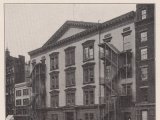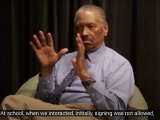You are here:
Deaf Social Spaces
Some of the first schools for Disabled people in the US were built for Deaf students. But in the 1800s and through much of the 1900s, many of those schools were not led by Deaf people.1 At times the schools were designed to shape Deaf students to be more acceptable to and more assimilated into hearing society, rather than recognizing that Deaf people had communities and cultures of their own. Nonetheless, Deaf students found ways to express themselves and communicate with joy.
Speaking through signing was an important part of this communication. Sign language is not a direct translation of English, but instead a distinct language with its own grammar, syntax, and vocabulary. There are multiple forms of sign language, including American Sign Language (ASL) and Black American Sign Language (Black ASL), which has various forms.2
Racial segregation in Deaf schooling, especially in the South, led to the development of Black ASL, which has roots in both ASL and African American Vernacular English. Many older practitioners of Black ASL report feelings of warmth, camaraderie and community when sharing stories in the language with each other.3
-
Kim E. Nielsen, A Disability History of the United States (Boston: Beacon Press, 2012). ↩︎
-
Caroline McCaskill, Ceil Lucas, Robert Bayley, and Joseph Hill, The Hidden Treasures of Black ASL - Its History and Structure (Washington, DC: Gallaudet University Press, 2011), 2, 3, 73, 76, 78, 86, 91, 161, Ebook Kindle version. ↩︎
-
McCaskill et al., The Hidden Treasures of Black ASL, 2, 3, 19-25; Allyson Waller, “Black, Deaf and Extremely Online,” The New York Times, January 23, 2021. ↩︎


